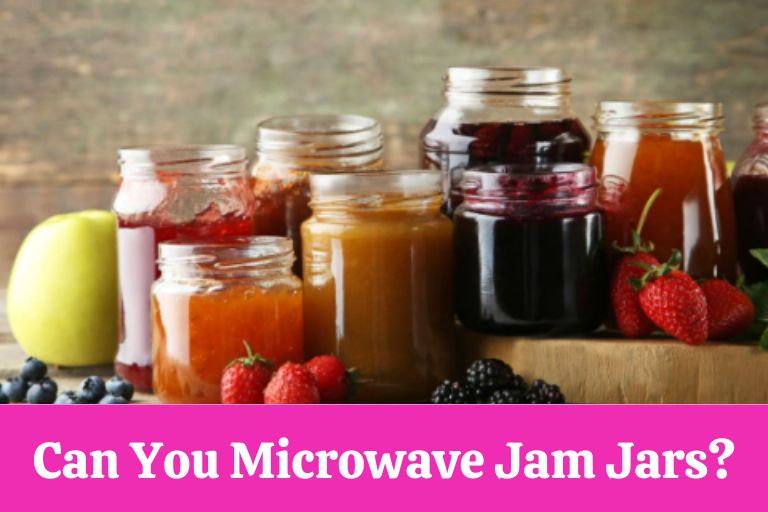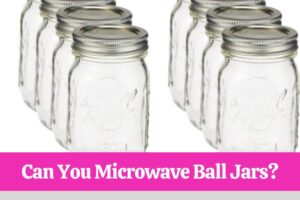Microwave ovens have become an essential part of our modern kitchen, offering convenience and quick meal preparation. However, when it comes to microwaving jam jars, there are certain safety concerns that need to be addressed.
In this article, we will delve into whether it is safe to microwave jam jars and provide you with the best practices to ensure a worry-free experience.
What Happens When You Microwave Jam Jars?
Microwaving glass containers, especially when they are empty, can have disastrous consequences. Glass, being a poor conductor of heat, can heat unevenly in a microwave, leading to thermal stress and potential shattering.
The sudden change in temperature can cause the glass to expand or contract rapidly, resulting in cracks or breakage. It is crucial to understand the behaviour of glass in a microwave to avoid mishaps.
Can You Microwave Jam Jars Safely?
The answer to this question depends on whether the jar is empty or filled with jam. Empty jam jars should not be microwaved due to the risk of shattering. However, if you have a jar filled with jam, it is possible to microwave it safely, provided you follow certain precautions.
The key is to ensure that you are using microwave-safe glassware to prevent thermal shock and breakage.
Tips for Safely Microwaving Jam Jars
To safely microwave jam jars, it is essential to select microwave-safe glass jars. Look for containers labeled as microwave-safe or heat-resistant. These jars are designed to withstand the temperature changes associated with microwaving.
Additionally, when heating jam in the microwave, it is advisable to use short intervals and stir in between to ensure even heating. This approach minimizes the risk of thermal shock and helps maintain the structural integrity of the jar.
Other Considerations When Microwaving Jam Jars
When microwaving jam jars, it is important to be mindful of the type of lids or caps used. Metal lids can cause arcing in the microwave, which can damage the oven or create a safety hazard.
Therefore, it is recommended to remove metal lids before microwaving and use microwave-safe covers instead. Additionally, if you are using plastic containers, ensure they are labeled as microwave-safe and do not contain BPA, as it can leach into the jam during heating.
FAQ:
Can jam jars be heated?
Yes, jam jars can be heated. However, it is important to follow proper heating methods to ensure safety and prevent damage.
Is it safe to microwave glass containers?
Yes, it is generally safe to microwave glass containers. However, it is crucial to use microwave-safe glassware to prevent thermal stress and potential shattering.
How do you know if a jar is microwave safe?
To determine if a jar is microwave safe, look for labels or markings on the jar indicating that it is specifically designed for microwave use. Additionally, check the manufacturer’s instructions or contact the manufacturer for confirmation.
How do you heat jars in the microwave?
When heating jars in the microwave, it is advisable to use short intervals of heating and stirring in between. This helps distribute the heat evenly and reduces the risk of thermal shock. Be cautious not to overheat the jars, as it can lead to breakage.
Are jam jars heat resistant?
Not all jam jars are heat resistant. It is important to choose jars that are specifically labeled as heat-resistant or microwave-safe to ensure they can withstand the heat generated by microwaving.
Will a jam jar break in boiling water?
It is possible for a jam jar to break in boiling water, especially if it is not specifically designed for high-temperature applications. Sudden temperature changes can cause glass to shatter, so it is important to handle glass jars with care when exposed to extreme heat.
What glass is not microwave safe?
Glassware that is not microwave safe includes glass with metallic trim or decorations, delicate glassware, and glass containers not specifically designed for microwave use. These types of glass can cause arcing or shattering in the microwave.
What is not microwave safe?
A8: Items that are generally not safe to microwave include aluminium foil, metal containers, metal-trimmed dishes, Styrofoam, plastics not labeled as microwave-safe, and containers with tight lids or caps that can cause pressure buildup.
What is the microwave safe symbol?
The microwave safe symbol is a square-shaped icon with wavy lines inside. It is usually found on microwave-safe containers and indicates that the item has been tested and deemed safe for use in the microwave.
What are three unsafe items that you cannot put in a microwave?
Three unsafe items that should not be put in a microwave are aluminium oil, metal objects, and Styrofoam. These items can cause damage to the microwave, create fire hazards, or release harmful substances when exposed to microwaves.
How do you heat a glass jar?
To heat a glass jar safely, it is recommended to use a microwave-safe glass jar. Place the jar in the microwave and heat in short intervals, stirring in between to distribute the heat evenly. Avoid overheating, as it can cause breakage.
Which containers are safe to use in a microwave and which are unsafe?
Safe containers for microwave use include glass containers labeled as microwave-safe, ceramic or porcelain dishes without metallic decorations and microwave-safe plastics. Unsafe containers include metal, aluminium foil, Styrofoam, and non-microwave-safe plastics. Always check the packaging or labels for microwave suitability.
Conclusion:
Microwaving jam jars can be done safely, provided you follow the right practices. Empty jars should be avoided to prevent shattering, while microwave-safe glassware should be used when heating jam-filled jars. By following these guidelines, you can enjoy the convenience of a microwave without compromising your safety. Remember, prioritizing safety and making informed decisions is essential when it comes to microwaving any type of glassware in your kitchen.




